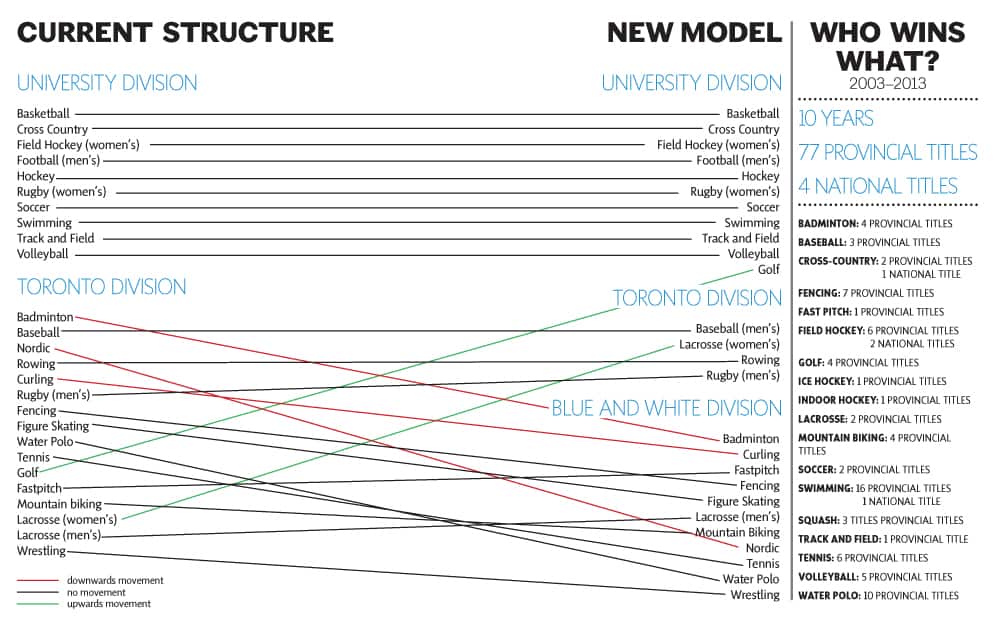On November 21, the long-awaited sports model proposal was released. It was created in order to re-evaluate the current model that was formed in the 1990s. The previous model sorted all varsity teams and varsity clubs into two categories: the University Division, which housed 10 sports, and the Toronto Division, which housed 18 sports. The model now has three divisions: the University Division, the Toronto Division, and the Blue and White division, with most teams in the last.
If the revised model is approved, then every team on the previous list would remain, except cheerleading, which was removed from the varsity sport or high-performance club rank before the model underwent its redesign.
The only sports that will remain in the Toronto Division will be men’s baseball, women’s lacrosse, men’s and women’s rowing, and men’s rugby — every other team previously categorized in that division will be demoted to the Blue and White division.
The model is based closely on the Ontario University Athletics (OUA) and Canadian Intercollegiate Sports (CIS) models in regards to the categorization of sports into divisions. Although U of T Athletics makes some minor adjustments from those models, such as classifying golf in the University Division — mainly due to their program’s financial support and their partnership with Angus Glenn Golf Club. The model will also be benefiting those teams previously considered high-performance clubs rather than varsity teams: fastpitch, men’s lacrosse, and mountain biking. Now, the teams will receive more funding than before and receive the same types of benefits as all of the other varsity teams in the division.
With all of the hype created with discussion about the new model, athletes, coaches, faculty, students, and alumni will be pleased with the fact that teams will continue to receive a fair amount of support, with many of the lower-ranked teams receiving more support than before.
The main change that will occrus in the model will be the scope of the programs. The model determines that months in which teams will be able to have priority over athletic and medical facilities in order train and practice for their seasons. The University Division will have the same benefits for the full year, while the Toronto Division will be provided with the benefits for six to eight months, and the Blue and White Division will for four to six months.
Along with the change in the scope of the programs, the level of support provided to each division will vary. The most significant variations will be between divisions, but there will also be inconsistencies in resource distribution among teams in the same divisions, depending on the teams’ requirements to
compete successfully.
“The challenge for Canada’s largest university is to offer a breadth of university high-performance sport opportunities for students that reflects the university’s size and diversity, while also providing a framework for athletic success at the provincial and national
levels — and doing all of this within fixed resources, “ said Beth Ali, director of intercollegiate and high performance sport.
“With the announced revisions, U of T’s intercollegiate program will remain the country’s largest,” she added.
“We’re looking at a way to maintain a broad base of programming, and find a way to maintain a strong student athlete experience, and a strong student experience for the rest of the student body as well, while still being able to focus our resources on being more successful,” said Ali.
Now that the model is fully drafted, it will go through a number of other phases that require other counsels and administration to approve it. As the discussion will be ongoing for the intercollegiate model, the tri-campus sports model and intramural sports model will be developed.
After a fully-approved intercollegiate model is set, it will be instituted, Ali hopes, by May, the start of U of T Athletics’ financial year, and will be implemented into the intercollegiate sports’ organization for the 2014–2015 season.
Every five years, teams’ placement in the model will be reviewed, which will give teams a chance to shift from one division of the model to another, if it seems called for. In some circumstances, they will move around based on how they are viewed and treated on a larger scale (the OUA and CIS scales), and other times they will be able to make a case for themselves in order to receive the perks that the higher-ranked teams receive.
“We have to have specific development plans for every team in every division. We will be as equitable as possible,” said Ali.
“But we will also be looking for the type of support that will make the student athlete experience really good, but also make the program as successful as it can be,” she said. “Hopefully create programs that are interesting, create some campus spirit and school pride. For the general student body and not just the athletes themselves.”


